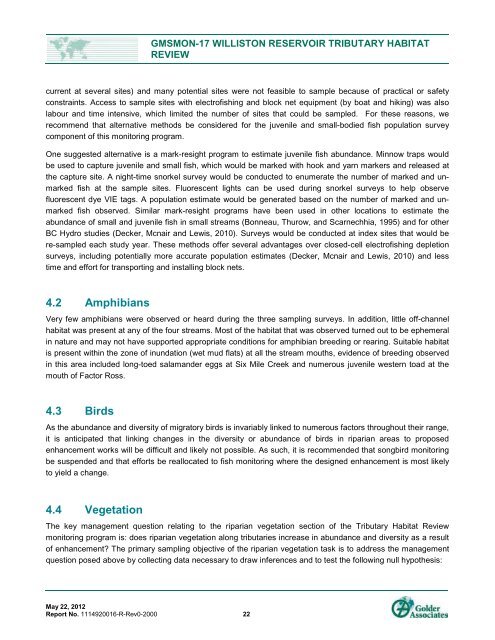GMSMON-17 WILLISTON RESERVOIR TRIBUTARY - BC Hydro
GMSMON-17 WILLISTON RESERVOIR TRIBUTARY - BC Hydro
GMSMON-17 WILLISTON RESERVOIR TRIBUTARY - BC Hydro
You also want an ePaper? Increase the reach of your titles
YUMPU automatically turns print PDFs into web optimized ePapers that Google loves.
May 22, 2012<br />
Report No. 1114920016-R-Rev0-2000 22<br />
<strong>GMSMON</strong>-<strong>17</strong> <strong>WILLISTON</strong> <strong>RESERVOIR</strong> <strong>TRIBUTARY</strong> HABITAT<br />
REVIEW<br />
current at several sites) and many potential sites were not feasible to sample because of practical or safety<br />
constraints. Access to sample sites with electrofishing and block net equipment (by boat and hiking) was also<br />
labour and time intensive, which limited the number of sites that could be sampled. For these reasons, we<br />
recommend that alternative methods be considered for the juvenile and small-bodied fish population survey<br />
component of this monitoring program.<br />
One suggested alternative is a mark-resight program to estimate juvenile fish abundance. Minnow traps would<br />
be used to capture juvenile and small fish, which would be marked with hook and yarn markers and released at<br />
the capture site. A night-time snorkel survey would be conducted to enumerate the number of marked and unmarked<br />
fish at the sample sites. Fluorescent lights can be used during snorkel surveys to help observe<br />
fluorescent dye VIE tags. A population estimate would be generated based on the number of marked and unmarked<br />
fish observed. Similar mark-resight programs have been used in other locations to estimate the<br />
abundance of small and juvenile fish in small streams (Bonneau, Thurow, and Scarnechhia, 1995) and for other<br />
<strong>BC</strong> <strong>Hydro</strong> studies (Decker, Mcnair and Lewis, 2010). Surveys would be conducted at index sites that would be<br />
re-sampled each study year. These methods offer several advantages over closed-cell electrofishing depletion<br />
surveys, including potentially more accurate population estimates (Decker, Mcnair and Lewis, 2010) and less<br />
time and effort for transporting and installing block nets.<br />
4.2 Amphibians<br />
Very few amphibians were observed or heard during the three sampling surveys. In addition, little off-channel<br />
habitat was present at any of the four streams. Most of the habitat that was observed turned out to be ephemeral<br />
in nature and may not have supported appropriate conditions for amphibian breeding or rearing. Suitable habitat<br />
is present within the zone of inundation (wet mud flats) at all the stream mouths, evidence of breeding observed<br />
in this area included long-toed salamander eggs at Six Mile Creek and numerous juvenile western toad at the<br />
mouth of Factor Ross.<br />
4.3 Birds<br />
As the abundance and diversity of migratory birds is invariably linked to numerous factors throughout their range,<br />
it is anticipated that linking changes in the diversity or abundance of birds in riparian areas to proposed<br />
enhancement works will be difficult and likely not possible. As such, it is recommended that songbird monitoring<br />
be suspended and that efforts be reallocated to fish monitoring where the designed enhancement is most likely<br />
to yield a change.<br />
4.4 Vegetation<br />
The key management question relating to the riparian vegetation section of the Tributary Habitat Review<br />
monitoring program is: does riparian vegetation along tributaries increase in abundance and diversity as a result<br />
of enhancement? The primary sampling objective of the riparian vegetation task is to address the management<br />
question posed above by collecting data necessary to draw inferences and to test the following null hypothesis:
















